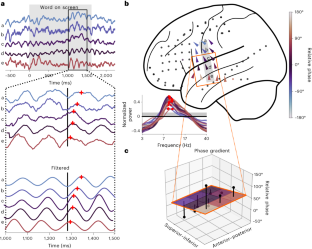2024-03-08 コロンビア大学
<関連情報>
- https://www.engineering.columbia.edu/news/brain-waves-travel-one-direction-when-memories-are-made-and-opposite-when-recalled
- https://www.nature.com/articles/s41562-024-01838-3
- https://www.cell.com/neuron/fulltext/S0896-6273(18)30417-3
シータ波とアルファ波の進行方向がヒトの記憶処理を調節する The direction of theta and alpha travelling waves modulates human memory processing
Uma R. Mohan,Honghui Zhang,Bard Ermentrout & Joshua Jacobs
Nature Human Behaviour Published:08 March 2024
DOI:https://doi.org/10.1038/s41562-024-01838-3

Abstract
To support a range of behaviours, the brain must flexibly coordinate neural activity across widespread brain regions. One potential mechanism for this coordination is a travelling wave, in which a neural oscillation propagates across the brain while organizing the order and timing of activity across regions. Although travelling waves are present across the brain in various species, their potential functional relevance has remained unknown. Here, using rare direct human brain recordings, we demonstrate a distinct functional role for travelling waves of theta- and alpha-band (2–13 Hz) oscillations in the cortex. Travelling waves propagate in different directions during separate cognitive processes. In episodic memory, travelling waves tended to propagate in a posterior-to-anterior direction during successful memory encoding and in an anterior-to-posterior direction during recall. Because travelling waves of oscillations correspond to local neuronal spiking, these patterns indicate that rhythmic pulses of activity move across the brain in different directions for separate behaviours. More broadly, our results suggest a fundamental role for travelling waves and oscillations in dynamically coordinating neural connectivity, by flexibly organizing the timing and directionality of network interactions across the cortex to support cognition and behaviour.
シータとアルファの振動はヒトの大脳新皮質における進行波である Theta and Alpha Oscillations Are Traveling Waves in the Human Neocortex
Honghui Zhang,Andrew J. Watrous,Ansh Patel,Joshua Jacobs
Neuron Published:June 07, 2018
DOI:https://doi.org/10.1016/j.neuron.2018.05.019

Highlights
•Theta and alpha oscillations are spatially clustered in the human neocortex
•Clustered oscillations display traveling waves
•Traveling waves generally propagate in a posterior-to-anterior direction
•Traveling waves can be modeled as coupled oscillators
Summary
Human cognition requires the coordination of neural activity across widespread brain networks. Here, we describe a new mechanism for large-scale coordination in the human brain: traveling waves of theta and alpha oscillations. Examining direct brain recordings from neurosurgical patients performing a memory task, we found contiguous clusters of cortex in individual patients with oscillations at specific frequencies within 2 to 15 Hz. These oscillatory clusters displayed spatial phase gradients, indicating that they formed traveling waves that propagated at ∼0.25–0.75 m/s. Traveling waves were relevant behaviorally because their propagation correlated with task events and was more consistent when subjects performed the task well. Human traveling theta and alpha waves can be modeled by a network of coupled oscillators because the direction of wave propagation correlated with the spatial orientation of local frequency gradients. Our findings suggest that oscillations support brain connectivity by organizing neural processes across space and time.


